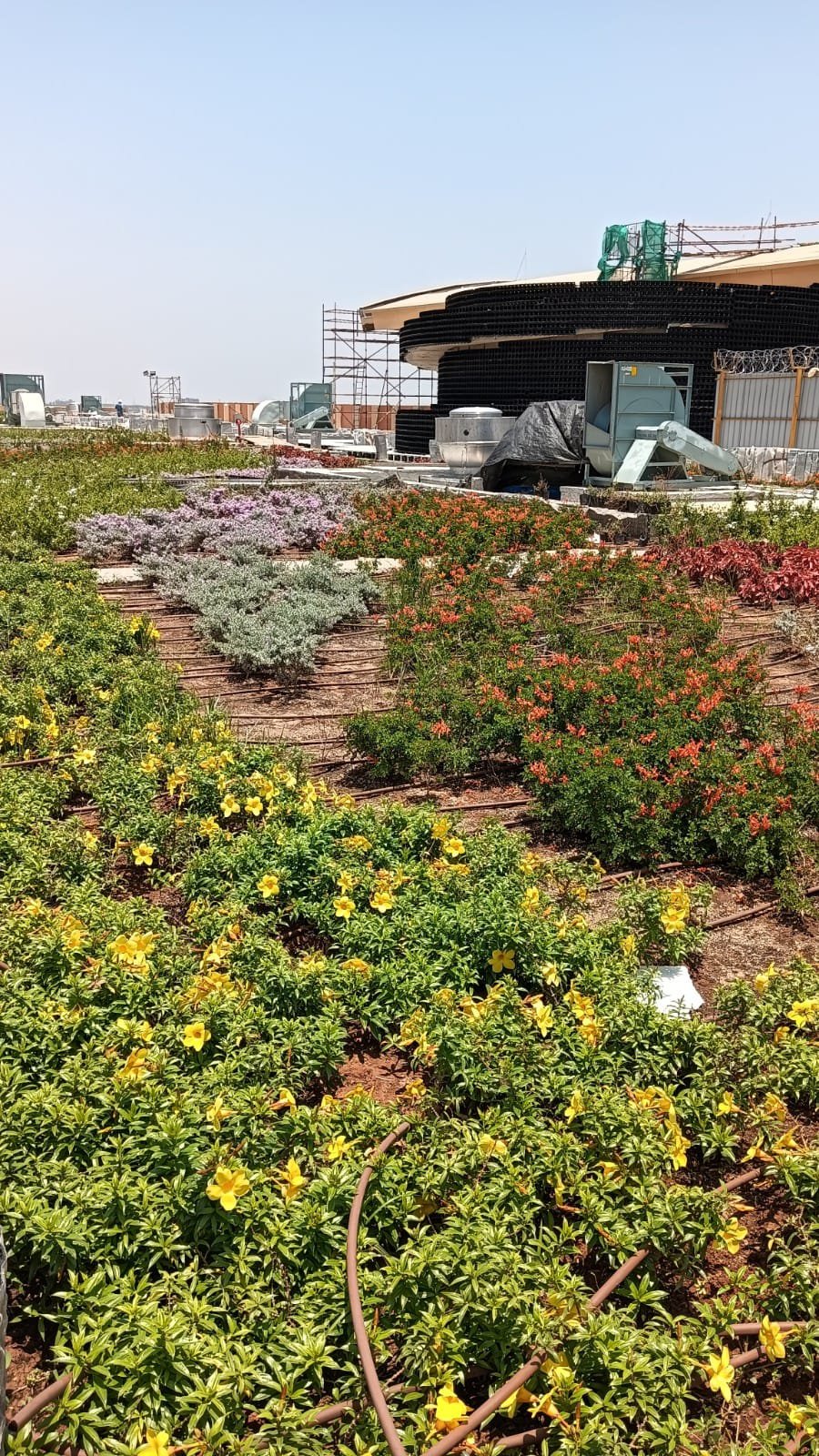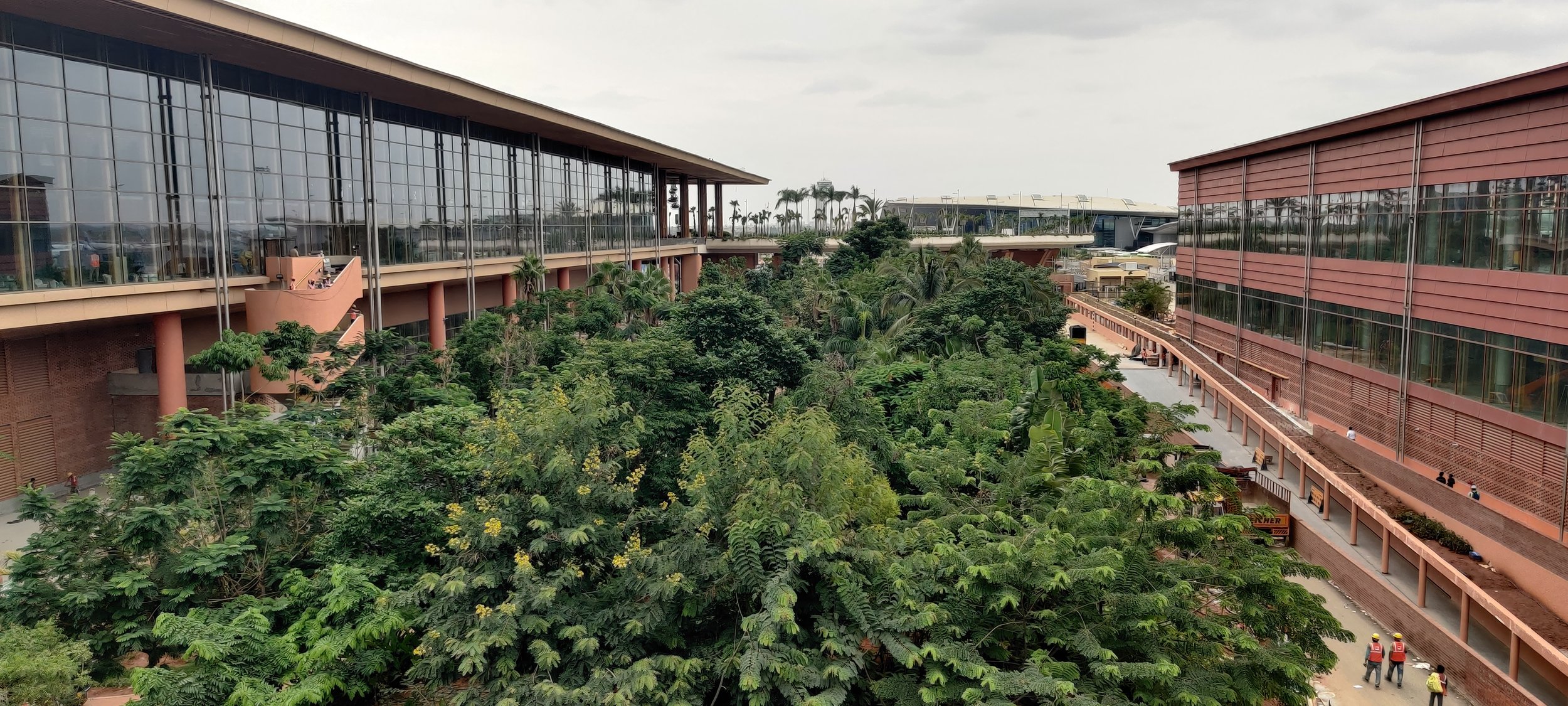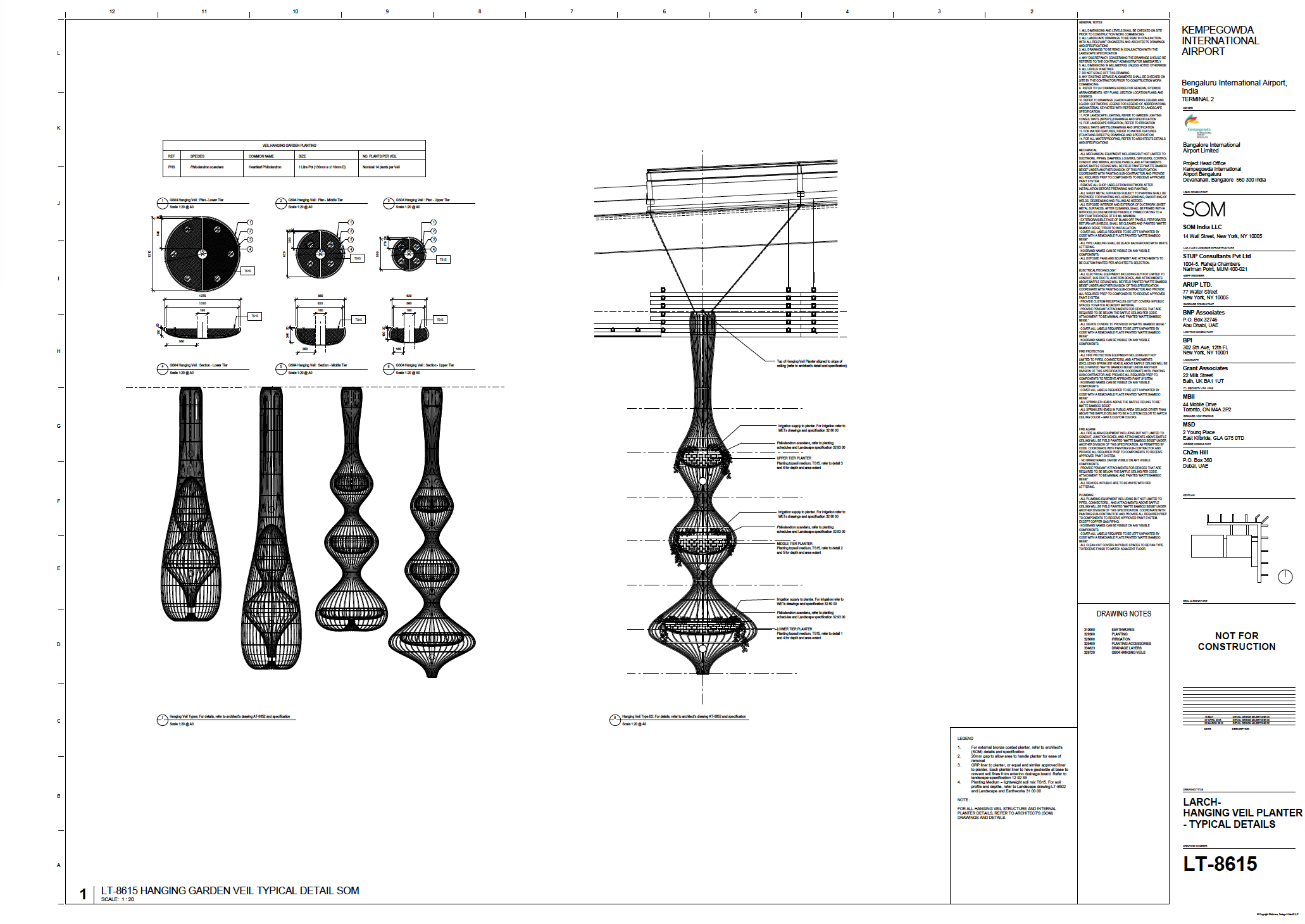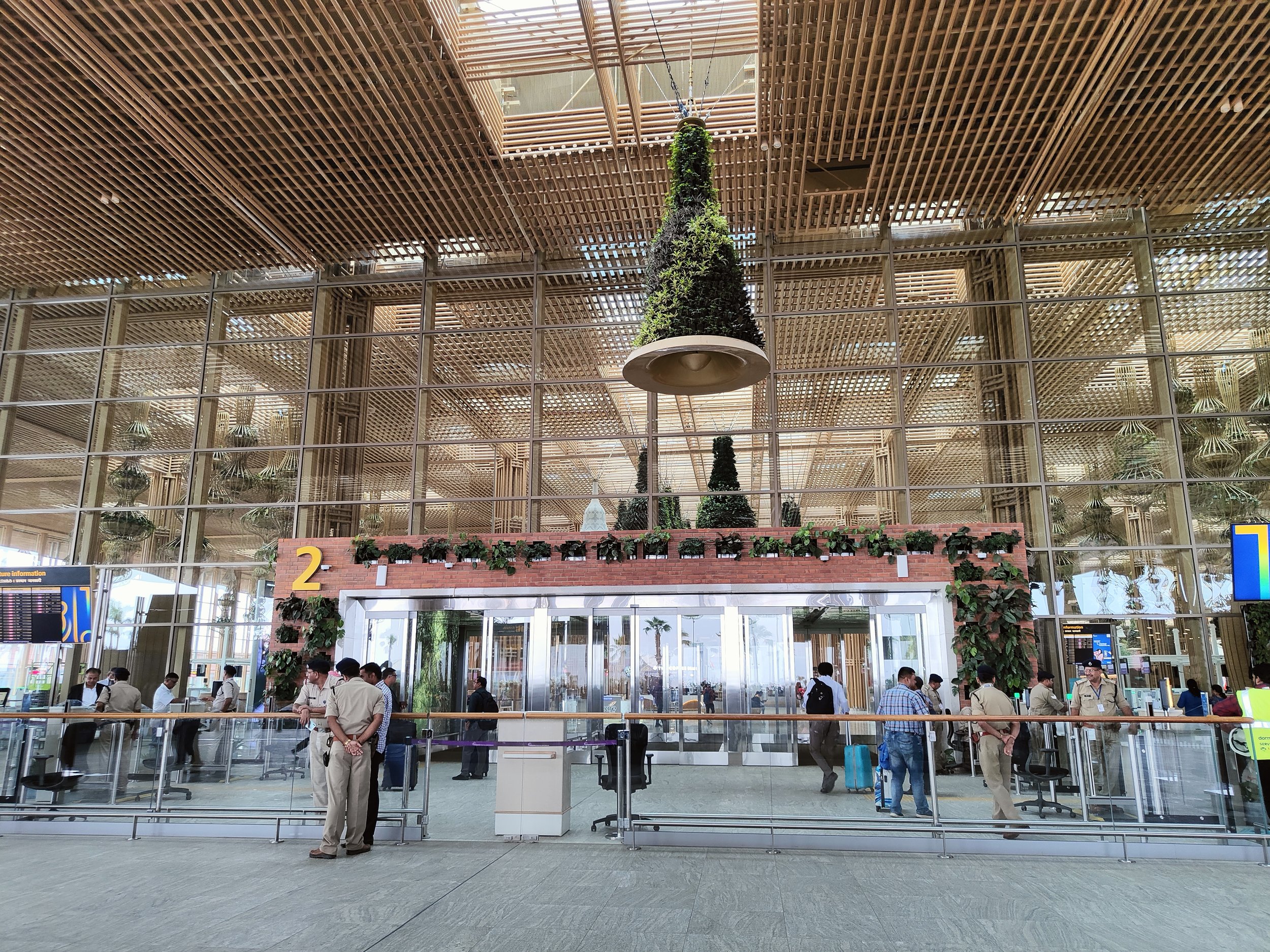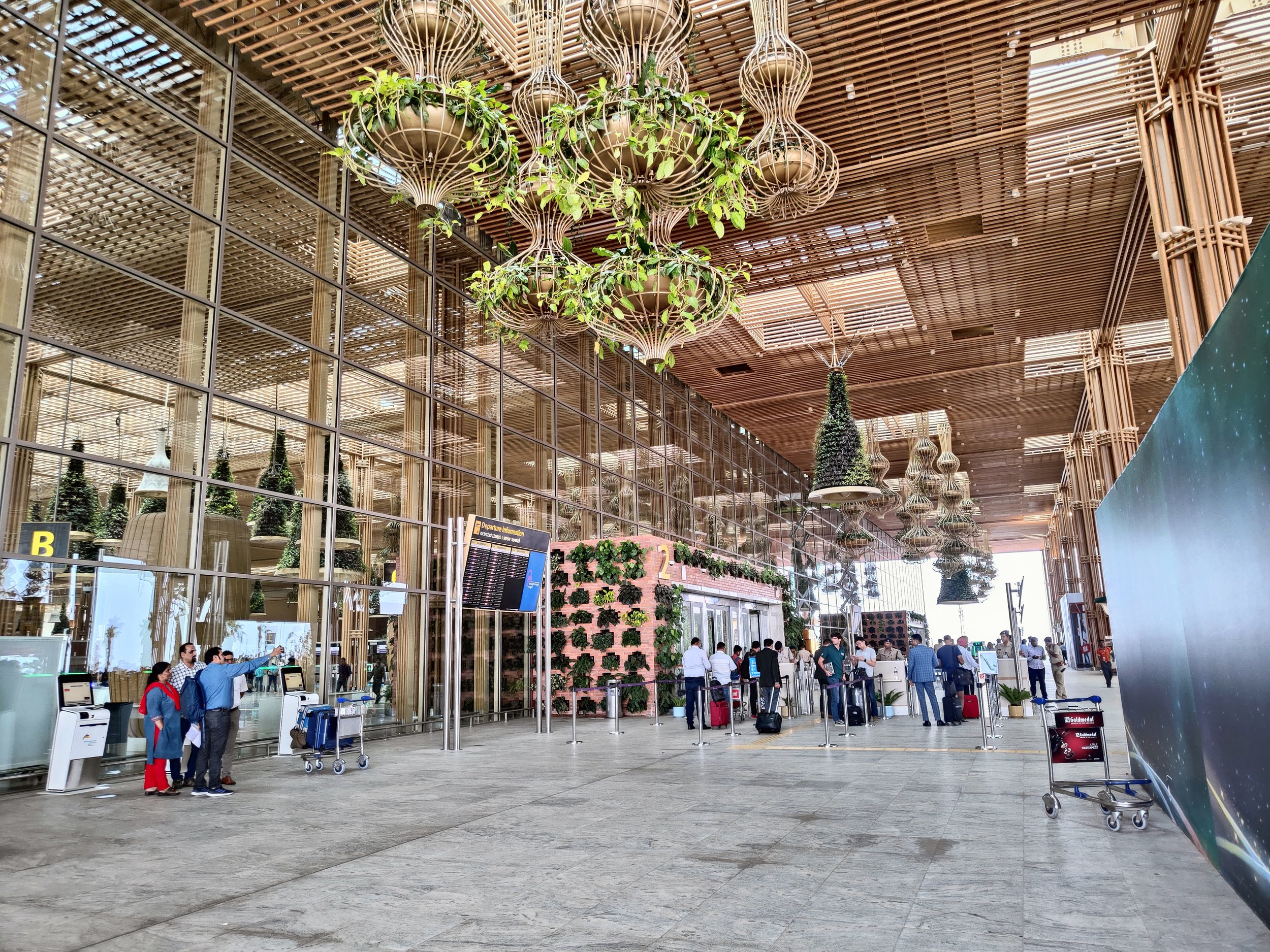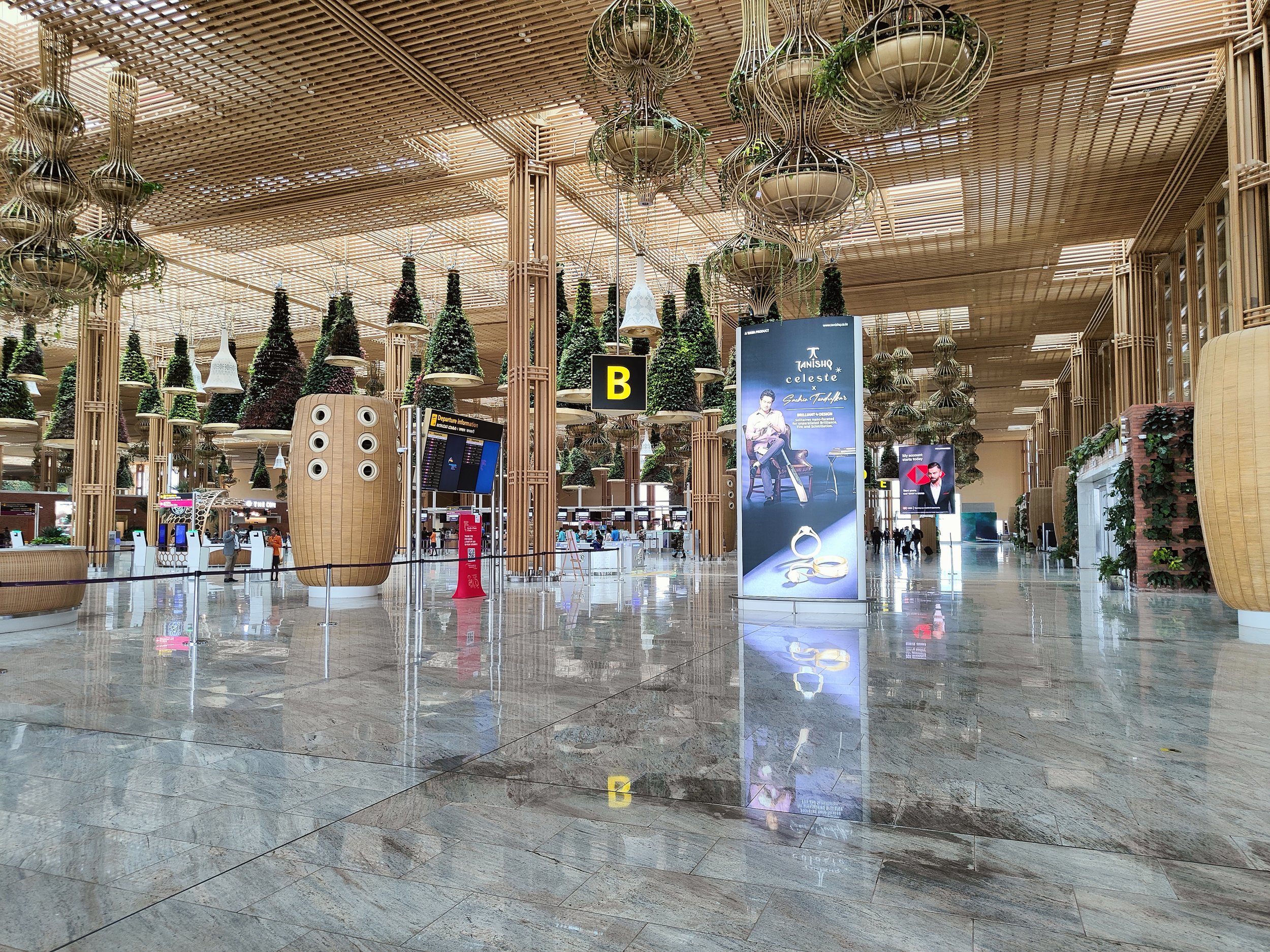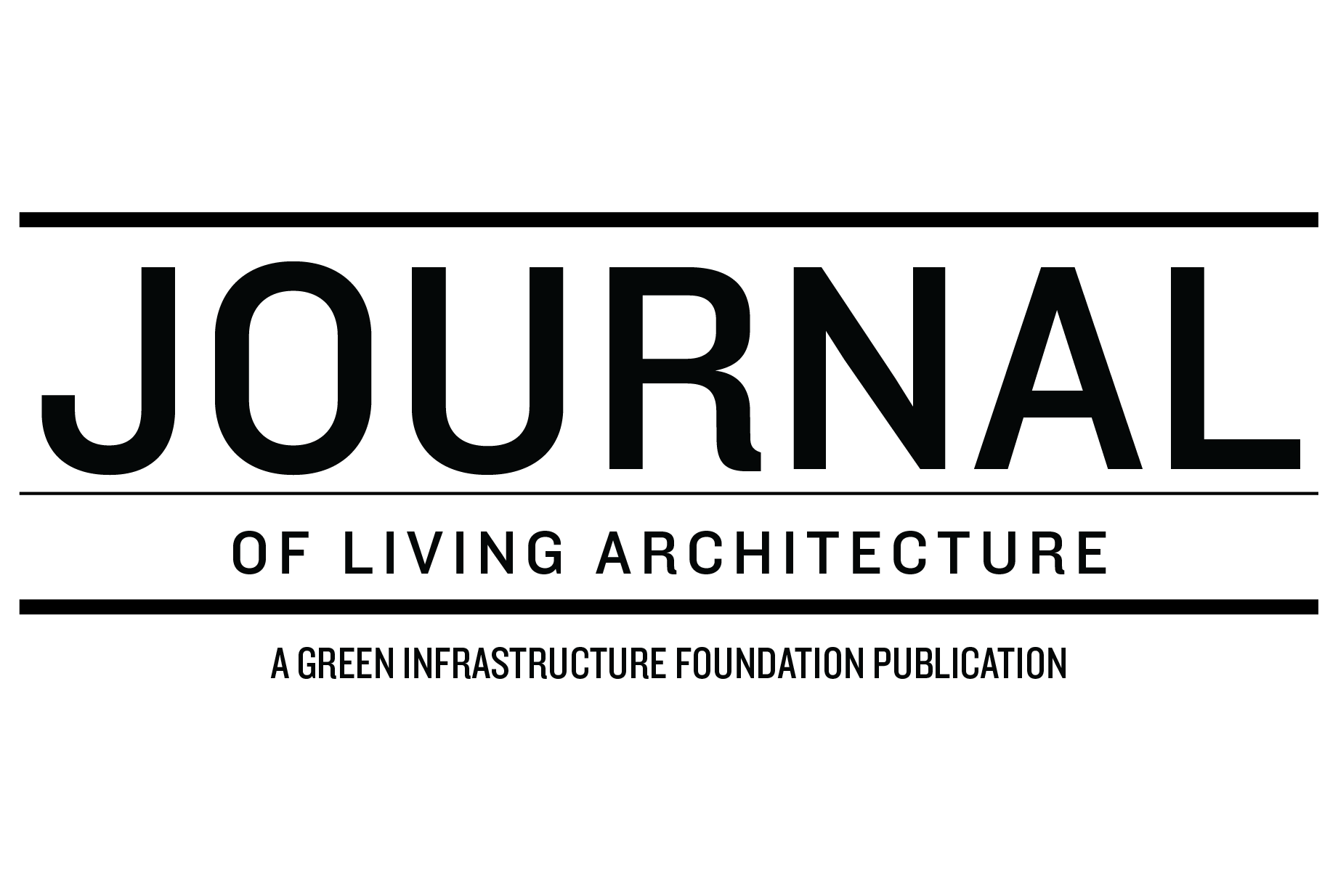A Terminal In a Garden: Exploring Bangalore’s New Airport
Advertisement
Plants integrated into the brick wall of Terminal 2. Photo: Kempegouda International Airport
Introduction
The design and the details were done by two of the world's most renowned architects, SOM and Grant Associates. The design had its own challenges and installation difficulties with the creating of 14-metre-tall built-up mounds resembling the surrounding mountains, the landscape of rural Bangaluru, inside the terminal.
The concept was complementing Terminal 2 airport design with the “City of Gardens Bangalore” idea. Bangalore the city, and Bangalore airport were always known for their beautiful landscapes and well-manicured and maintained greenery. Accepting the responsibility to drive the airport to a newer elevation was nothing less than a dream in 2018. The second terminal of Kempegowda International Airport in Bengaluru is a new addition to the airport that highlights the rich history and culture of the Indian state of Karnataka
The terminal is being constructed in two phases, with the first phase covering an area of 255,645 square meters and being able to accommodate up to 25 million passengers each year. The second phase, which is still in the planning stage, will handle an additional 20 million passengers each year.
It was a clear maturity of thought to exceed from being a ‘Terminal in a Garden’ pre Covid era to a ‘Terminal in a Biodiversity Hotspot’ post Covid. The situation has taught us a lot of lessons, like moving from the concept of me to we!
A rooftop garden. Photo: Kempegouda International Airport
Change was inevitable on a larger canvas of sustainability driven infrastructure, wellbeing of the environment and nature in which we as humans are part. These ideas lead us to look at becoming a campus which can be a safe haven for large flora of Indian, as well as global tropical and sub-tropical plants, which can be conserved for generations to come. Here is an overview of the design and installation process and challenges for this unique project.
Saving Top Soil
It all started with saving the top soil - God's ultimate living biome which sustains life on earth! The entire top 6-8’’of soil on the site was scraped off and stored carefully. This is a priceless element that cannot be recreated in labs. By reusing it we ensured that we were able to reintroduce the microbes which sustain the landscape above them.
Transplantation
Another impressive feat was India’s largest transplanting and storing of nearly 7,900 trees; some of which were 20 plus years old and more than 50 Species. Many species of trees and palms were planted as well as more than 100,000 shrubs, all of which had to be exercised with utmost precision. Our overall success was measured by the survival rate which was surprising.
Advertisement
Forest Belt
The Forest belt encompasses the Terminal and boarding piers holding around 2000+ plant species of Indian origin. The Forest belt is a wonder itself comprising about 4 acres of 90 per cent compacted profile, trees averaging 10 meters in height were selected for this man-made forest area. As an international passenger you will be having a unique forest canopy walk by September 2023 after completion of an 18 meter-tall bridge above the trees canopy.
One of the key features of the airport is its biodiversity, with about 600 to 800 year-old trees and over 180 rare, endangered, and threatened species of Indian origin. Overall, 1200+ tree species are part of the terminal's ecosystem.
A forest belt with different types of trees, providing the terminal a biophilic view. Photo: Kempegouda International Airport
Bamboo cladding adds to the biophilic and nature based design of the airport. Photo: Kempegouda International Airport
Unique Indoor Aesthetic – Local Art and Biodiversity
The Terminal has over 923 kilometres of fire-resistant bamboo cladding that adds to its garden-like environment and new colour appeal. Rubbing shoulders with all the greenery and technology is the Terminal 2 Art Programme, which is inspired by Bharata’s Navarasa as mentioned in the Natyashastra (Science of Indian dance forms). To begin with Terminal 2 will feature 60 artworks by 43 artists from across Karnataka and other Indian States, along with ongoing initiatives to showcase the significant cultural diversity and art forms of southern India.
With hanging gardens and eye-catching structures, Terminal 2 is an epitome of modern infrastructure, rooted in local culture and most importantly it is green and sustainable. The hanging structures from the ceiling are two types of decorative planters—some in the shape of bells and others designed as a chain of onion baskets one above the other, called veils. Overall, there are 500 such systems, each holding hundreds of plants. Hence, hanging from the ceiling alone are 150,000 live plants of various species.
In addition, about 450,000 live plants grow in the green walls that line the corridor between the check-in counters and security gates. In total, there are a total of 600,000 live plants in the terminal building so passengers can explore a garden environment as they walk through the terminal
Advertisement
The airport has been designed and developed to offer passengers an immersive experience in exploring the unique flora sourced from multiple ecological habitats in India. Precisely, right from the entry into the BLR Airport campus from the Main Access Road (MAR) to entering Terminal 2 and then boarding aircraft at the piers, passengers will be visually treated with all shades of green. From 10,235 square meters of green walls around the terminal, hanging gardens that cascade down from the terminal roof on the bronze veils and bells suspended from the ceiling, and the green lagoons within the premises to the extensive forest belt area between the terminal and boarding piers, passengers will experience greenery like never before.
As a potential biodiversity hotspot, a total of 620 endemic plants, 3,600+ plant species, 150 palm species, 7,700 transplanted trees, 200 varieties of lilies, 96 lotus species and 180 rare, endangered, and threatened species and 10 ecological habitats make up the lush green landscape around Terminal 2. Being close to nature and efforts of creating habitats lead us to a campus having 310+ species of Butterflies and Moths ,200 Species of pollinators, Fire flies which were missing since 1985 back in millions of numbers. Blue Mormon and the closest to my heart were the Southern Bird wing back naturally.
Planting beds surround the airport. Photo: Kempegouda International Airport
Green Walls, Hanging Gardens, Green Roof and Interior Planting Beds
Together, these green infrastructure elements hold more than 500 Species of various climates of World. The world is becoming increasingly urbanized which results in ‘concrete forests’ taking the place of natural vegetation and forested areas. This has contributed to the total isolation of cities from nature. This change had led to an upshot of pollution, temperatures, and energy consumption in cities. So, it is necessary to make efforts to preserve and stretch the green area by adopting green concepts into urban development. These are highly agreed substitutes for bringing greenery back to urbanized cities.
With this, Terminal-2 has incorporated various green elements to reflect Bengaluru’s ‘Garden City’ image which is intended to create the first true Garden terminal in the world. Passengers using this terminal should feel an experience of being in a garden which connects with nature and this Terminal will bring a sense of the natural world to every part of the journey. Passengers are drawn through the departure’s forecourt to the entrance vestibules which are designed to enable plants to grow vertically in the modular pockets which acts as a connection between the outside and inside, giving an extravagant visual quality to the main entry gate.
As we get into the terminal green walls are strategically located to emphasize the garden effect along the main passenger flows. Using vertical landscape to accentuate the routes in compact space. By the time of the completion, the project was the biggest success with its 3,500 square meter area.
Advertisement
A biodiverse green wall awaits international passengers. Photo: Kempegouda International Airport
Sourcing and Selecting Plants
Sourcing and pre growing of plants at nursery for mass installation at Terminal started in 2020. The proposal was to use plants that will create a 3D relief and depth to the walls and add to the lush feel of the gardens. We had a separate 2-acre polyhouse which was in BIAL premises for pre growing of plants for a period of 2 years which was run by natural resources. Plants were sourced from all over India which requires a lot of scientific knowledge and longtime experimentation. Since most of the plants supplied were from tissue culture and local nurseries grown in soil media, all these plants were replanted in hydrophilic media and placed in modules.
Please find below the Soilless mix media composition: combination of complete inert media % ratio per KG.
NEUTRAL PEAT MOSS - 45%
COCOPEAT - 15%
COCO CHIPS - 15%
PERLITE - 10%
VERMICOMPOST - 10%
CHARCOAL - 2.50%
NEEM CAKE - 2.50%
The size, the shape, the growth rate, the water consumption, and the light requirement are the main considerations of plant selection, to comply with the site conditions. Plants which are in uniform quality and growth were shifted to site for installation whereas others were left in polyhouse for further development. Full planting plans have been proposed for each of the walls, each to reflect the specific design character. We very well understood by this time that concept design and installation are only the first step of achieving a successful green wall. The main factor of a beautiful green wall lies in the proper maintenance, and it must be taken into consideration during the design phase itself.
The ease of maintenance is very much influenced by the initial selection of the plants and the green wall system. Make sure that the irrigation system functions properly and check the health status of plants regularly to ensure they are maintained. The maintenance is a more critical consideration when planning large installations at high profile buildings like airports, and the maintenance access should be integrated with Terminal Operations.
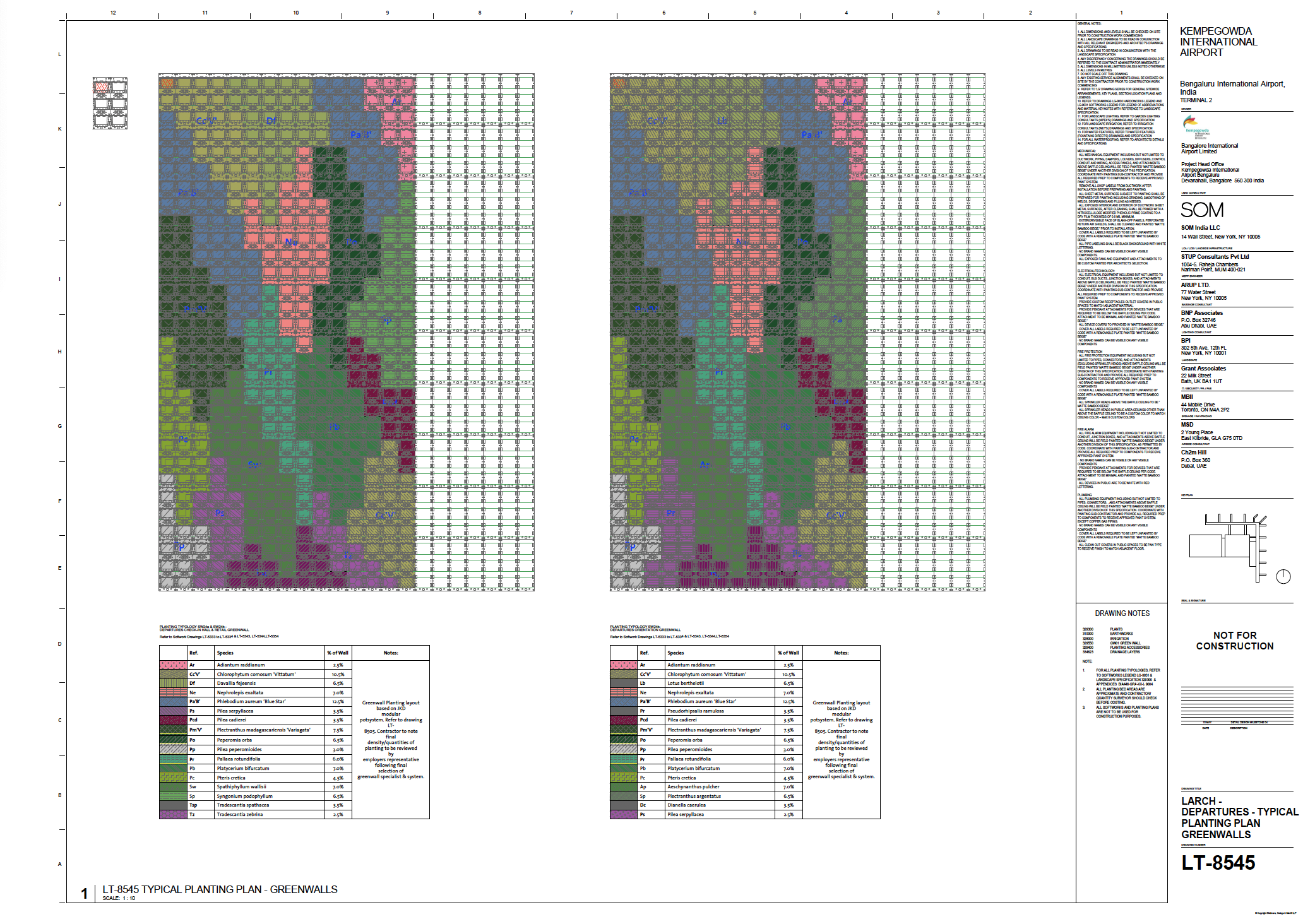
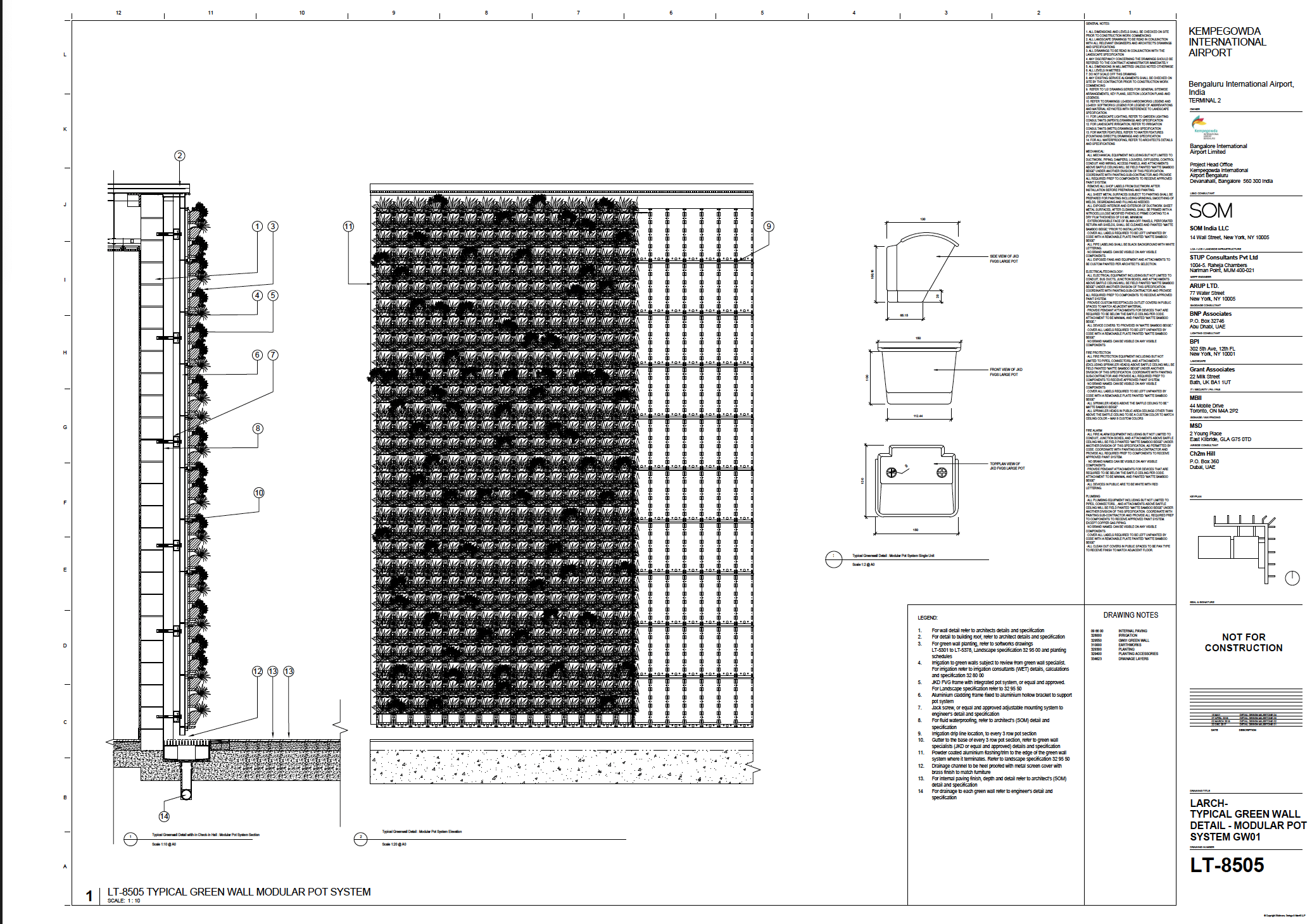
Use of Mock-ups
Next was the execution. We had a Mock-up approval from management and started installation of structural panels at site which were mounted on waterproofed walls, including drainage channels within each green wall wherever required. All the modules were installed on these panels later when the site was conducive for planting, the plants were shifted to site for installation. All the modules and other accessories of the green wall are fire resistant. The irrigation system was built into the green wall system which operates through sensors which are automatically controlled by a server installed in a technical room behind the garden. In the evening the green walls are highlighted with lighting to create a focal point by reflecting their beauty to the rest of building
Figure on the left: A planting plan for the green wall at the airport. Photo: Kempegouda International Airport
Advertisement
Planting and Hanging Bells and Veils
As we started working on the hanging veils with our vendor partners, we found that there were too many details involved, and more and more people started getting involved and working on this. Finally, 6 major vendor partners and more than 5 internal teams of different mindsets were involved here with the same passion of getting this impossible task made possible.
Yes, we had the clock ticking against us as we had to say management is this going to happen or not? Started working on getting a mock-up ready at Terminal 2 construction site to prove to management and ourselves if this will work or not.
Hanging bells make even the light fixtures surrounded by plants. Photo: Kempegouda International Airport
With Covid hitting us and making people far away from each other for a project like this where more than 50 individual stakeholders are involved was a humongous task to take this forward, collaborating ideas from all and getting each one to a same page was really a pain! With all this we started production for the bells and veils mock-ups as soon as we were out from covid lockdown, and our 1st veil was shifted to BIAL terminal 2 on 14th July 2020. Now that we got the veil in hand, we planned for erection of the same to a 16-meter-high ceiling weighing almost the weight of a small elephant with all safety and lifting equipment and finally our 1st veil erection was done successfully on 30th September 2020 in the mock-up area. We successfully completed the hanging of 349 number of veils & 120 number of bells at Terminal 2.
While we set about the making of bells and veils, we were also working on the planting plans, selection of plants, procurement of plants and mainly acclimatization of plants to air-conditioning temperatures. We got our vendor partners on board in 2021 and started to build a polyhouse for about 1 acre to keep all the plants to pre grow them before they get installed at the Terminal 2 site. Plants were also tested for their performance in controlled temperatures and humidity levels.
Getting these bells and veils planted after they were hung was a nightmare for our team. At this point, there were more than 100+ vendors, 1000+ workers working all time 24/7 for finishing all the Terminal 2 aspects. We are working with a plant (living thing) in an environment where there was too much dust all around. It was very difficult and shifting more than 100,000 plants to hanging structures was a pain, as you can’t reach them without access to equipment. The use of this equipment was limited to certain working hours, by safety precautions and the load we can take on the equipment. We could not have enough access equipment because we did not have enough space to move around on the floor due to multiple other Terminal works happening. It was a major challenge we had to overcome. The date to remember was 8th October 2022. It’s finally installed!
The design work for the hanging bells. Photo: Kempegouda International Airport
Advertisement
Climate Smart Water Use
Kempegowda International Airport (KIA) is the first airport in India which adopted weather based Smart irrigation system for its complete landscape area in Landside, Airside, Inside and Surrounding of Terminal; and Sensor based IoT systems for its unique Hanging gardens at Terminal-2. The plants are nourished by a fully automated irrigation system, run on harvested rainwater, ensuring that they thrive and maintain their lushness.
The first of its kind irrigation system can be controlled from a computer and mobile phone. The smart system irrigates plants based on monitoring various parameters like evapotranspiration, soil moisture and weather conditions. Climate smart micro irrigation system which is completely automated runs on weather station information which records 5 parameters and provides the daily evapotranspiration per zone to set the irrigation cycle. It is one of a kind in the world. Every drop is utilized efficiently. Root zone irrigators, clever use of inline drip tube discharge rate of 1-2.3 LPH @spacing of 400mm distance. Efficient use of soil moisture sensors, water level sensors and rain sensors help us to utilise the blue wealth efficiently.
Forest of Abundance (FOA)
FOA is a Rare Plant Museum which presents knowledge of plants from the 7000+ years of historical texts of India as well as ancient cultures of the World. Trees which are sacred by being the source of oxygen, food and other needs known to us were planted in about 20 + acres of the FOA experience centre. The FOA includes plants mentioned in many of the world’s religions including Hindu, Jain, Buddhism, Judaism, Christianity, Islam, and Sikhism. One of the stories presented in the FOA is walking the life of Rama in 17 agroclimatic zones with about 150 trees mentioned in his life story of Ramayana. Plants associated with the lives of 24 Tirthankaras(Gurus) of Jain religion, 28 Buddhas. Trees in the Bible and Quran are also featured. Trees of Nations, Date of birth wise trees, Month of Birth wise trees, Medicinal and so on and so forth. The intent is to give space which will educate generations to come and to help conserve, preserve and bring back the rare, endangered, and critical plants and make them common again. Narrate the story being part of nature and appreciate the value we inherit.
Advertisement
Conclusion
Designed to achieve sustainability through structural efficiency and economy through modularity, Terminal 2 has been recognised as the largest terminal in the world to be pre-certified with a Platinum LEED rating by USGBC (US Green Building Council). Overall, Terminal 2 at Kempegowda International Airport is a unique and innovative addition to the airport that showcases the beauty of nature and the culture of Karnataka. The idea of creating a self-sustaining airport business was at the core of BLR Airport’s planning and strategy, and sustainability is one of the key principles that continues to guide our business and growth.
When BLR Airport was recently ranked second on the prestigious ‘Cirium 2022 On-Time Performance Review’ with 84.08 per cent on-time departures, it validated our commitment to providing world-class service. From ensuring seamless journeys for passengers with our technological innovations, round-the-clock customer care and service, to implementing environment-friendly measures that directly impact not just passengers but communities living around its premises, BLR Airport continues to strive to deliver best-in-class service while being a front-runner in the field of sustainability.
More images of the planting bells. Photo: Kempegouda International Airport
Advertisement
Prasannamurti Desai, is the Vice President, Head Landscape, Bangalore International Airport Limited, Kempegouda International Airport. Prasannamurti is an experienced Landscape Horticulture professional with over twenty-four years of experience. Starting his career in India, he has worked in the fields of real estate both residential and commercial projects, Golf courses, High end hotels and Airport Landscape. His broad experience extends through the arid climate to the tropical Sub-continent and temperate climate of 18 states of India. His international experience includes Sri Lanka and Maldives. Had design managed and delivered more than 50 million Sq. of built Landscape projects with Tata Housing and Raheja Universal. Email Prasannamurti here.
He is a long-standing Member of the Chartered Institute of Horticulture (MCHort), American Society of Landscape Architects (ASLA).
Currently he delivered Bangalore International Airport’s Landscape department. Spearheading the Landscape development themed around-“Terminal in the Garden” for the largest airport expansion infrastructure development of the country.
Terraforce supplies large scale retaining wall project in India. - Terraforce
View this youtube video showing the full airport terminal.
Acknowledgements and More Information
A big thanks to Mr. Hari Marar, MD and CEO, a passionate human being and source of inspiration to exceed the expectation and entire management of BIAL for trusting us.


